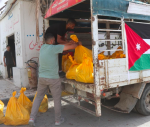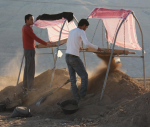You are here
The Taliban's war on women and girls
Aug 24,2022 - Last updated at Aug 24,2022
By Yasmine Sherif and Gordon Brown
LONDON — When Taliban leaders visited an elementary school in Kabul in October 2021, two months after retaking control of Afghanistan, several seven- or eight-year-old girls bravely stood up, one by one, to declare: “Our classes have resumed, but not for our older sisters. We have been promised that our older sisters will return to class, but this has not happened yet!”
Now, on the first anniversary of the Taliban’s return to power, most of Afghanistan’s 1,880 girls’ secondary schools remain closed. And when women and girls demonstrated in Kabul this past weekend, calling for their educational opportunities to be restored, Taliban forces fired shots over the protesters’ heads.
Islam’s holy book, the Koran, encourages both women and men to read, contemplate and pursue education. The Prophet Muhammad advocated education as a religious duty for males and females: “Seek education from the cradle to the grave,” the Prophet instructed. But the Taliban’s ban on schools for girls above sixth grade has made Afghanistan the only Muslim country to prohibit girls’ secondary education.
In August 2021, the Taliban promised Afghans and the rest of the world that they would reopen all primary, secondary and tertiary schools for both boys and girls. Girls’ secondary schools were expected to reopen on March 23 to coincide with the Persian New Year. But when the girls arrived at the school gates, armed Taliban guards refused them entry.
A few days later, dozens of female students protested near the ministry of education in Kabul. “Open the schools! Justice! Justice!” they chanted, holding banners declaring that “education is our fundamental right, not a political plan”. The Taliban, however, remain unconvinced. As a result, Afghanistan’s girls, nearly one million of whom have no access to secondary education, are the world’s most forgotten children and adolescents.
No one should remain silent in the face of this discrimination. Islam has 1.8 billion adherents, making it the world’s second-largest religious group, comprising 24 per cent of the global population. In Indonesia, the largest Muslim-majority country, women’s university enrollment has increased from 2 per cent in 1970 to nearly 33 per cent today. In Saudi Arabia, half of university-age women attend university, a higher rate than in Mexico, China, Brazil and India.
According to a World Economic Forum report, 30 per cent of the 450 million women in Muslim-majority economies are in paid work. Although women’s labour-force participation rates vary widely, 74 per cent in Kazakhstan, 53 per cent in Indonesia and Malaysia, 42 per cent in the United Arab Emirates, 33 per cent in Turkey, 26 per cent in Pakistan, and 21 per cent in Saudi Arabia, they are increasing faster than for men in nearly all these economies. Muslim women’s combined income of just under $1 trillion would make them the world’s 16th most prosperous country.
After four decades of armed conflict and climate-induced natural disasters, Afghanistan is one of the world’s poorest and least-developed countries. But the Taliban are denying the female half of the workforce the chance to help rebuild it. Afghanistan cannot afford to regress a quarter-century to the start of the Taliban’s first stint in power in 1996, when the group prohibited women and girls from working outside the home, attending school and university or leaving their homes unless accompanied by a mahram (husband, father, brother, or son). Back then, the Taliban’s religious police meted out severe punishment, including stoning, for any infraction of their moral code.
Prior to the Taliban’s 1996 takeover, 60 per cent of Kabul University teachers (and nearly half the students) were women. In addition, women constituted 70 per cent of schoolteachers, 50 per cent of civilian government workers (and 70 per cent of the 130,000 civil servants in Kabul), and 40 per cent of doctors.
Today, with Afghanistan facing economic collapse, soaring poverty and increasing risks of starvation, and unable to survive without humanitarian assistance, the Taliban are arguing that girls’ current school uniforms are not Islamic. But most Afghans do not think long black tunics and pants and a white head scarf (hijab) designed in accordance with Hanafi jurisprudence will solve the country’s many deep-rooted problems.
Nonetheless, the Taliban are threatening to close down those girls’ secondary schools that have remained open in major provinces, such as Balkh in the north, unless they change their dress codes. “The requirements on hijab are getting tougher day by day,” one teacher told Human Rights Watch. “They have spies to record and report... If students or teachers don’t follow their strict hijab rules, without any discussion they fire the teachers and expel the students.”
Meanwhile, some Taliban me mbers who can afford to are sending their daughters abroad to study. Others are trying to convince the organisation’s religious leadership in Kandahar to rethink the ban and let girls return to secondary school.
In March, the foreign ministers of the G-7 countries and Norway, together with the European Union’s High Representative for Foreign Affairs and Security Policy, issued a joint statement condemning the Taliban’s refusal to reopen girls’ secondary schools. “We call on the Taliban urgently to reverse this decision, which will have consequences far beyond its harm to Afghan girls,” they said.
But more must be done. The international community, specifically countries in the region, and especially members of the Organisation of Islamic Cooperation, should make Afghan women’s and girls’ rights central to their diplomatic and economic negotiations with the Taliban. Afghanistan and its people have suffered enough. Anyone who cares for the country’s future must stand up for adolescent girls’ right to an education, and women’s right to work.
Yasmine Sherif is director of Education Cannot Wait, the United Nations global fund for education in emergencies and protracted crises. Gordon Brown, a former prime minister and chancellor of the exchequer of the United Kingdom, is United Nations special envoy for Global Education, chair of Education Cannot Wait’s High-Level Steering Group, and chair of the International Commission on Financing Global Education Opportunity. Copyright: Project Syndicate, 2022.














